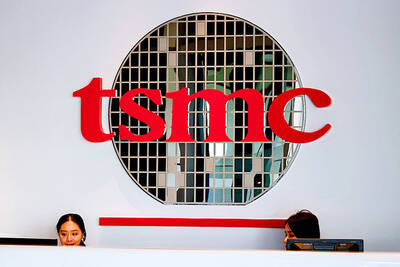Netbooks have been the PC market’s bright spot for the past nine months, but sales have slipped recently, and they now face an uncertain future. They are losing some of their price advantage over notebooks and soon will be challenged by a new type of ultra-slim notebook PC with a long battery life.
Netbooks first appeared in 2007 and have been a big success. Sales have far outstripped the predictions of analysts such as Gartner — 14 million units last year, against a forecast of 5.3 milllion — and now make up 20 percent of the portable PC market.
The Asus marketing specialist John Swatton points to “tech novices” adopting netbooks in the way they have adopted mobile phones and MP3 players, which he says “will drive further growth in the netbook market. We are also seeing more and more users purchasing netbooks as a second, and more portable, device to provide connectivity when away from their primary laptop or PC.”

PHOTO: AP
“The netbook has changed the landscape for good,” says Ian Fogg, an analyst with Forrester. “The netbook category has overturned the idea that users should pay a big price premium for ultraportables.”
Ultraportable notebook PCs have been available from companies such as IBM and Sony, but they typically cost £1,500 (US$2,425) to £2,500. Today’s netbooks cost around £200 to £300, which makes them affordable enough for everyday commuters. Women like them because they can fit inside a handbag. Kids like them because they can have their own machine, and they may get one from their school — Dell has just launched a rubberized Latitude 2100 in a variety of colors for the education market.
The netbook has also changed PC retailing, as high-street stores now sell them with USB modems for portable Internet use.
The Gartner analyst Ranjit Atwal says: “Sales through the telecoms channels have opened up a new target market.”
The netbook has even changed the competitive landscape for PC manufacturers. The booming netbook market has not been driven by US companies but by three suppliers from Taiwan: Asus, Acer and MicroStar International (MSI).
On Gartner’s figures for this year’s first quarter, Acer’s sales grew by 26.7 percent in a declining market and it is now shipping roughly as many PCs worldwide as Dell. Because of the success of the Acer Aspire One, the company expects to be the market leader by volume in Europe this year.
However, the netbook market seems to have slowed. US-based DisplaySearch indicates that while first quarter netbook sales were up by 556 percent compared with the same quarter last year, they were down by 26 percent sequentially, compared with the fourth quarter of last year. Notebook sales declined 24 percent sequentially, so netbooks are no longer growing against the market trend.
This may be partly to do with the increase in specifications that has pushed up netbook prices. The classic netbook was cheaper than a notebook because it had a 7-inch screen, a small Flash drive, an Intel Atom processor and used Linux instead of Microsoft’s Windows Vista. Today’s netbooks have 10 or 12-inch screens, 160 megabyte hard drives and run Windows XP. It is still cheaper to make a netbook than a notebook, but the gap has narrowed.
Linux’s failure in the UK market has been striking because the three Taiwanese manufacturers were keen to support it and both Asus and Acer launched their first netbooks with Linux only. But after Microsoft made a cheap version of the supposedly obsolete XP available for ultra-low-cost PCs, Windows took over.
Acer’s European boss, Massimo D’Angelo, says Linux sales are “very, very minimal” — less than 5 percent — while Asus and MSI have also seen rapid declines.
MSI’s UK marketing manager, Richard Stewart, says: “We offered Linux for the first six or nine months of the Wind, but, as time went on the gap [to Windows] increased to the point where it wasn’t worthwhile to offer Linux any more. “
This is not just the failure of Linux, it is the failure of the netbook idea. You were supposed not to need a big hard drive and a powerful processor running Windows because all your applications would be on the Net, and you’d access them via a browser. But it seems most people preferred the system they already knew.
Atwal says that when consumers buy new phones they are usually prepared to learn a new user interface — “but on a phone, you’re more likely to be viewing rather than creating content. I think that’s the dividing line. When you’re creating content, you’re going to go with Windows.”
The problem with consuming as against creating, he says, is that “most PC vendors haven’t been able to segment their product lines on that basis, which is why we’re seeing bigger keyboards and screens on netbooks. Then the chance of netbooks taking more of your mainstream market becomes much more apparent.”
And that could be bad news. Netbooks are cheaper, and have slimmer profit margins, so vendors would rather sell you a notebook. Asus and MSI, of course, had fewer notebook sales to lose.
Netbooks and notebooks are going to get even closer this year, for two reasons. First, Intel and the PC vendors are launching a new PC platform code-named Montevino Plus, for CULV (Consumer Ultra-Low Voltage) machines. Second, Microsoft is launching Windows 7, which has been optimized so that even the Ultimate version will run pretty well on a netbook.
Acer looks like being first to market with the new platform in its Timeline series. MSI has also announced its first machine, the X340 X-Slim, which is like a MacBook Air, but lighter and much cheaper. Asus is announcing its new systems at the Computex trade show in Taiwan at the beginning of next month.
CULV machines will offer a similar sort of battery life to netbooks, perhaps 6-8 hours. They may also weigh about the same — MSI’s X-340 is 1.3kg, in spite of having a 13.4-inch widescreen. But they will have the processing power required for content creation, rather than content consumption.
Initially, CULV machines will be two or three times the price of netbooks, but PC vendors think they will sell.
Acer’s UK managing director, Bobby Watkins, says: “Half my demand from the channels [retailers] for the back-to-school period is for Timeline. They believe the pull for it is going to be really, really strong.”
The result could be that netbooks blend into the bottom part of the notebook market, with screens up to 12 inches in size, rather than being a distinct category. The question is whether consumers will pay for what they appear to want — a light, slim notebook with a decent screen and long battery life — or whether they are buying netbooks mainly on price.
Microsoft similarly expects the demand for Windows 7 to be strong, and it is encouraging vendors to pre-install the Home Premium version on all the machines aimed at consumers — both netbooks and notebooks. The netbook suppliers want a cheaper version to maintain their price differential. Microsoft has a Starter version that will do the job well on a netbook (where applications are run in the browser) but won’t be much good for notebook use, because it will only run three applications at once.
The danger is that PC vendors will turn to another free operating system instead: Google’s Android version of Linux, as used in the G1 mobile phone. That could emerge as the big battle over the next year.

FIREPOWER: On top of the torpedoes, the military would procure Kestrel II anti-tank weapons systems to replace aging license-produced M72 LAW launchers Taiwan is to receive US-made Mark 48 torpedoes and training simulators over the next three years, following delays that hampered the navy’s operational readiness, the Ministry of National Defense’s latest budget proposal showed. The navy next year would acquire four training simulator systems for the torpedoes and take receipt of 14 torpedoes in 2027 and 10 torpedoes in 2028, the ministry said in its budget for the next fiscal year. The torpedoes would almost certainly be utilized in the navy’s two upgraded Chien Lung-class submarines and the indigenously developed Hai Kun, should the attack sub successfully reach operational status. US President Donald Trump

TPP RALLY: The clashes occurred near the Chiang Kai-shek Memorial Hall on Saturday at a rally to mark the anniversary of a raid on former TPP chairman Ko Wen-je People who clashed with police at a Taiwan People’s Party (TPP) rally in Taipei on Saturday would be referred to prosecutors for investigation, said the Ministry of the Interior, which oversees the National Police Agency. Taipei police had collected evidence of obstruction of public officials and coercion by “disorderly” demonstrators, as well as contraventions of the Assembly and Parade Act (集會遊行法), the ministry said in a statement on Sunday. It added that amid the “severe pushing and jostling” by some demonstrators, eight police officers were injured, including one who was sent to hospital after losing consciousness, allegedly due to heat stroke. The Taipei

NO LIVERPOOL TRIP: Taiwan’s Lin Yu-ting, who won a gold medal in the boxing at the Paris Olympics, was embroiled in controversy about her gender at that event Taiwanese boxer Lin Yu-ting (林郁婷) will not attend this year’s World Boxing Championships in Liverpool, England, due to a lack of response regarding her sex tests from the organizer, World Boxing. The national boxing association on Monday said that it had submitted all required tests to World Boxing, but had not received a response as of Monday, the departure day for the championships. It said the decision for Lin to skip the championships was made to protect its athletes, ensuring they would not travel to the UK without a guarantee of participation. Lin, who won a gold medal in the women’s 57kg boxing

The US has revoked Taiwan Semiconductor Manufacturing Co’s (TSMC, 台積電) authorization to freely ship essential gear to its main Chinese chipmaking base, potentially curtailing its production capabilities at that older-generation facility. American officials recently informed TSMC of their decision to end the Taiwanese chipmaker’s so-called validated end user (VEU) status for its Nanjing site. The action mirrors steps the US took to revoke VEU designations for China facilities owned by Samsung Electronics Co and SK Hynix Inc. The waivers are set to expire in about four months. “TSMC has received notification from the US Government that our VEU authorization for TSMC Nanjing